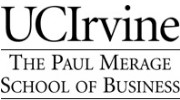Final quarter is moving through quickly. I only have 2 classes plus an independent study for my internship at Silverpoint Investments. Forecasting is a numbers class; any numbers class comes very easy to me. The other class is Merage's Edge course. Edge is a very interesting course that encourages students to use web2.0 tools to mobilize action whether in your company or your customers or your suppliers. I was part of the student advisory committee to help set the course syllabus. I was asked to give a quick presentation on how I use blogging to build professional value (see my professional blog here), but my main contribution has been pushing the class to adopt Twitter.
Twitter is a new web2.0 technology that, in over-simplified terms, is the most efficient means of communicating to your network. Think of a more active and constantly used facebook update that you can access online and through cell phone text messages. It is still in early adopter phase, but I am highly confident it will go mainstream like blogging has. I am proud to say that Merage is probably one of the few (if not the only) MBA school that is using the technology in one of its classes. A blogger recently posted that he gave a presentation to Stanford MBAs and was disappointed to discover only handful knew of the technology. So I pushed the Edge prof to have the class experiment with it. Many students use it to have a side commentary to speaker presentations. We used it in our last class to formulate more relevant questions to steer the speaker to topics that interested us. This is bleeding edge for MBAs and I am excited to drive its adoption.
We have a pretty interesting project for our Edge class. It is to set up an Amazon store and raise funds for special charitable/non-profit projects. My team had a very good learning lesson early. I have worked with most of them in the past and our traditional method of working was to divide up the project into little pieces to work on individually. When due, we assemble our parts, polish, and usually we get a very good grade. This project has proved to be very difficult to use this method. Many of the individual assignments did not get done or were done very poorly. I hypothesize that this is due to the interconnectedness of the individual tasks and the need for creativity.
The level of interconnectedness means that my work product can impact my partners work product or shift my perception on how my partner should do his project. This means that as we do our work our perception of the project as a whole continually changes. Therefore, when we reconvene it creates frustration because people's views have changed since we last met and results in the desire for constant changes. By forcing people to work in teams of two or three on these interconnected tasks, while the team's perception may change it is easy to share that new perception as they work on other tasks because they are group not an individual. I think this theory could be a post of its own.
I am becoming a strong believer that creative projects are done best in a collaboration of a small (read 2-3 people) teams. Most MBA's are analytical in nature and not necessarily the natural creative types. Thus, if you send us off on our own to come up with creative solutions, it may produce mixed results. But, when two or three work together and build off their each other's ideas, I feel the creative product is dramatically improved. This EDGE project demands some creativity. Therefore, when we work on our own, the quality of our creative product is very mixed.
We are trying to adjust how we work, but I am finding that we are very set in our ways. Even when we agree to collaborate more on the smaller project tasks, we generally resort to dividing the task up into smaller parts and again working on our own. So, I am not sure how well we will do on this project.
Saturday, May 10, 2008
Subscribe to:
Post Comments (Atom)


No comments:
Post a Comment